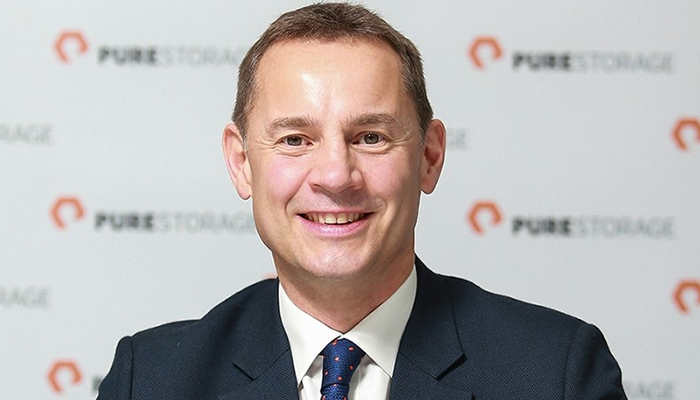Most of us remember a time, not long ago, when sustainability efforts and IT strategies were not talked about in the same conversation. But that’s changed, fast. Now, there are only a few organisations that don’t have environmental footprint and energy reduction high on their agenda.
“Scalability has become important to customers as they look to make the most of investments without being tied into purchasing technology they don’t use for several years.”
James Petter, VP and GM International, Pure Storage
Technology is embedded in our personal and professional lives. For some, sustainability and the digital world are unrelated. However, IT has a huge impact on energy consumption as the amount of data we create in work and private contexts grows exponentially. In 2020, the world generated 64.2 zettabyes. In 2025, we’re on course to almost triple that, with over 181 zettabyes — that’s 181 billion terabytes.
Research shows that 2-4% of global greenhouse emissions come from ICT which includes anything and everything related to data generation. Many analysts predict that the global carbon footprint of digital tech will double by 2025. Add to these issues the growing mountain of e-waste generated from legacy rip and replace processes and there’s another important element to future looking green technologies.
It’s important to note that technology does have the capability to help us to live more sustainably as we use IT to work, stay connected, and enjoy ourselves, all with less travel and fewer materials consumed. In order to do that, IT leaders need to examine their entire tech stack to ensure solutions are as green as possible. If this is incorporated into IT agendas, there is a remarkable opportunity to positively contribute to energy reduction, shape a greener future and set precedents that define our world for decades to come.
Sustainability is a responsibility
Most of us remember a time, not long ago, when sustainability efforts and IT strategies were not talked about in the same conversation. But that’s changed, fast. Now, there are only a few organisations that don’t have environmental footprint and energy reduction high on their agenda. Organisations want to incorporate greener solutions and processes into their day to day operations and they’re adding these issues to RFPs.
From a regulatory perspective, as governments introduced new rules and mandates, every company looked to find ways to cut emissions and improve sustainability. When these requirements first started to spring up, some companies staked out sustainability as a USP and public sentiment has turned ‘being green’ into a competitive advantage. Now, it’s become a necessity as sustainability is a shared responsibility for everyone: individuals, governments and private companies all need to play their part to contribute to reducing carbon.
Business priorities and environmental impact
Agility and efficiency have been well established as pillars of business success; pillars which cross over with sustainability efforts. As people generate more data, it becomes imperative to seek out sustainable technology solutions as a key element to reducing energy use.
Flash storage is the perfect example of a technology that does this. Flash-based storage arrays use less power, take up less space and require less cooling than the equivalent, disc-based storage. Infrastructure solutions should be agile and adaptable, ready to deploy without complete overhauls, ready to expand capacity on-demand as customers need and also reduce energy consumption and emissions.
Sustainable by design, delivery and default
Looking at the tech sector more broadly: entire tech lifecycles, solution design and delivery models have come under scrutiny. This is understandable given the growing number of RFPs that focus on the green credentials of technologies and companies.
In terms of design: a more modular approach has become the norm in recent years, allowing specific components to be replaced as needed, instead of entire systems: embedding sustainable design into hardware and software. The supply chain issues experienced by the whole technology industry have also brought this into sharp focus — agility in how these issues are solved is front of mind for customers looking for reassurance that their solutions are sustainable. An additional benefit is that there is less hardware turnover and therefore less e-waste sent to landfill.
Scalability has become important to customers as they look to make the most of investments without being tied into purchasing technology they don’t use for several years. An as-a-service model allows organisations to only pay for the resources they need, without taking on the management of those resources at the back end. Plus they get the absolute most out of their investment and cut waste dramatically. This approach means technology can be managed centrally by a vendor or service provider who’s set-up and incentivised to work as efficiently as possible. This leads to lower levels of energy consumption and far less waste, as companies no longer need to run under-used or over-sized systems. Effective, efficient and sustainable.
A positive future with the right leadership
So it would seem that IT departments and tech providers are primed to lead us towards a sustainable future. Well, yes and no. The potential is there, for sure. The World Economic Forum has already suggested that by 2050, digital technologies could reduce global emissions by 20% in the three highest-emitting sectors: energy, materials, and mobility.
But the WEF acknowledges that this can only happen if the right technologies are used. Technologies that have efficiency at their core; that avoid unnecessary waste and support sustainability goals. All organisations have a responsibility to implement greener processes. Technology companies need to be focusing on embedding greener methodologies and practices within their core design so that it becomes an automatic process.
Within individual companies, those technologies could be a force for leaner, greener business. First, they must be chosen by leaders with the innovative vision and drive to put them to work.


